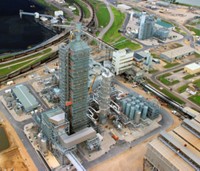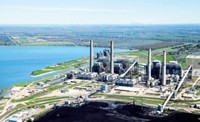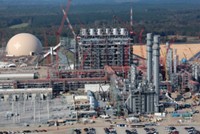Advertisement
Grab your lab coat. Let's get started
Welcome!
Welcome!
Create an account below to get 6 C&EN articles per month, receive newsletters and more - all free.
It seems this is your first time logging in online. Please enter the following information to continue.
As an ACS member you automatically get access to this site. All we need is few more details to create your reading experience.
Not you? Sign in with a different account.
Not you? Sign in with a different account.
ERROR 1
ERROR 1
ERROR 2
ERROR 2
ERROR 2
ERROR 2
ERROR 2
Password and Confirm password must match.
If you have an ACS member number, please enter it here so we can link this account to your membership. (optional)
ERROR 2
ACS values your privacy. By submitting your information, you are gaining access to C&EN and subscribing to our weekly newsletter. We use the information you provide to make your reading experience better, and we will never sell your data to third party members.
Environment
Carbon Capture And Sequestration Technologies Face A Bleak Future In The U.S.
The U.S. lacks incentives to develop technologies that reduce carbon dioxide emissions from coal-fired power plants
by Jeff Johnson
July 16, 2012
| A version of this story appeared in
Volume 90, Issue 29

The long-term future of coal in the U.S. may rest with the success of a handful of demonstration projects that will attempt to capture emissions of carbon dioxide, a greenhouse gas, from coal-fired power plants. At present, carbon capture and sequestration (CCS) is the most likely route to reducing the contribution of coal-fired power plants to climate change.

To download a PDF of the full article and table, visit http://cenm.ag/projects.
Yet CCS’s future looks bleak. To protect coal and coal jobs, coal-related industries and coal-state politicians have fought hard and have successfully blocked climate legislation, but in doing so, they have killed the primary reason for developing CCS technology.
The demonstration projects are the first to move past small pilot projects and apply bench-scale technologies to full-scale plant operations. With funding from industry and the Department of Energy, the eight projects are intended to apply CCS technologies at three industrial facilities and five electric power plants. The smaller, less expensive industrial projects are progressing. The bigger power plant projects are just getting under way; the farthest along is only about half complete.
Technology developers have had difficulty obtaining financing and justifying spending the billions of dollars needed to scale up these so-called clean-coal technologies. According to officials from DOE, industry, and energy think tanks, CCS developers face a complex problem. In addition to the normal and expected hurdles that are part of the development of any new technology, CCS promoters have been hit by a perfect storm in today’s political and economic climate: a high financial wall without any economic or regulatory driver to encourage investments in expensive pollution cleanup technologies.
“What a difference a few years makes,” says Pamela Tomski, senior fellow in the energy program of the Atlantic Council, a Washington, D.C., think tank.
“The high point for legislative action on climate change,” Tomski points out, came in 2009. That year, the House of Representatives cleared legislation to require CO2 reductions and a cap-and-trade program that would have put a cost on carbon emissions. Despite passing by a razor-thin, seven-vote margin, the bill signaled hope for a low-carbon future, she says (C&EN, July 6, 2009, page 8).
Just a year later, a watered-down version of the bill died on the Senate floor. With its demise, the primary drivers for CCS—a price on carbon emissions and a CO2-trading scheme—also expired.
Today, a majority of Congress members have no interest in putting a price on carbon. In addition, many members even challenge the scientific basis of climate change.
Although no price has been set on carbon, CCS research has been getting some support because of global warming. DOE has set a goal of having commercially viable CCS technology by 2020, notes a recent report by the nonpartisan Congressional Budget Office. To meet this target, according to the report, DOE has provided some $6.9 billion in R&D funding since 2005. Half of that total came from the American Recovery & Reinvestment Act of 2009, President Barack Obama’s stimulus package.
The R&D funding alone has proven inadequate to make CCS application economically viable, CBO states. It estimates that electricity from power plants using CCS would be 75% more expensive than electricity from conventional coal-fired power plants because of the cost of new equipment, primarily devices to capture CO2.
To lower those costs, the report warns, CCS technologies must be demonstrated at hundreds of commercial-scale coal power plants to ensure they can economically capture CO2, compress it, pipe it, inject it, and permanently keep it deep underground and out of the atmosphere.
Similarly, recent studies by the Congressional Research Service and the Worldwatch Institute find a great need for CCS but little follow-through for expansion of demonstration projects at commercial plants.
Without technology such as CCS to reduce coal’s CO emissions, coal is likely to find it increasingly difficult to compete in a greenhouse-gas-constrained world against electricity generators that do less climate damage, such as natural gas, renewable energy sources, or nuclear power.
Coal currently plays a huge role in the nation’s power mix, but its share of the market is sliding. In 2011, coal generated 39% of U.S. electricity, making it the largest source of electricity. But in 2010, it accounted for 47% of U.S. electricity. The drop is due to gains in electricity-generating efficiency, a decline in the U.S. economy, and the growth of electricity generation from natural gas.
Gas’s share jumped from 22% in 2010 to 26% in 2011. With record levels of production and plummeting prices of natural gas, that growth is expected to continue. Latest figures from DOE’s Energy Information Administration (EIA) show that natural gas accounted for 28.7% of U.S. electricity during the first quarter of 2012, compared with 20.7% from the same quarter last year.
In contrast, coal’s share of U.S. electricity generation in the first quarter declined from 44.6% in 2011 to 36.0% this year. However, coal retains its leadership in greenhouse gas emissions: It is responsible for about one-third of the U.S.’s anthropogenic CO2 emissions and 80% of CO2 emissions from the electricity sector, according to EIA.
Government policies to cut CO2 emissions from coal-fired power plants and allow the continued use of coal have proven impossible to implement. “There is a conflict in the U.S.,” says Robert Hilton, vice president of power technologies for government affairs at Alstom, a global construction and engineering firm. “While there is strong support for coal, there is no driver for CCS.”
According to Hilton, a financial and regulatory impasse killed Alstom’s CCS efforts in the U.S. Instead, Hilton says, Alstom is focusing on two new projects in China and is a lead participant in a new CCS demonstration facility in Norway. “At Alstom, we have begun talking about the U.S. piggybacking on projects being done in the rest of the world.”
With frustration in his voice, Hilton describes what happened at Alstom’s biggest U.S. project: Last July, the Midwestern utility American Electric Power (AEP) terminated a project to construct a commercial-scale advanced CCS technology add-on to its 1,300-MW Mountaineer Power Plant in West Virginia. Alstom would have built the CCS system, which would have been the world’s largest at a coal-fired power plant.
AEP’s goal was to capture 90%, or 1.5 million metric tons, of the CO2 from the exhaust stream from 235 MW of the plant’s capacity by 2015. After two years of planning and construction of a $100 million pilot facility at the site, AEP canceled the project. AEP also rejected a $334 million offer from DOE to aid the project, which the company would have had to match.
“We are in a classic ‘which comes first’ situation,” said AEP Chairman Michael G. Morris at the time, adding that there was no “viable path forward.” That’s because to recover its construction costs, AEP would need approval from its public utility commission. “As a regulated utility,” Morris explained, “it is impossible to gain approval to recover our share of the costs for the technology without federal requirements to reduce greenhouse gas emissions.”
The regulatory uncertainty, he added, also made it difficult to attract financial partners to help fund the industry’s share of the construction project. It died from a combination of U.S. climate policy confustion coupled with a weak economy, according to AEP.
“The rates we charge customers are set by public utility commissioners,” notes Pat D. Hemlepp, AEP’s director of corporate media relations. “The commissioners said this was an excellent project, but AEP is not required to do it. So they are not going to authorize cost recovery. It is a valid position.
“It is difficult to show any justification for carbon capture when Congress has taken no action and has not indicated that any action would take place, period,” Hemlepp continues. “A utility would be very reluctant to build a new power plant with CCS. There is no known technology that can do it and no idea of what will be required in the future.”
To avoid the unknowns associated with coal, the push will be toward natural gas for electricity production, Hemlepp says. The price of natural gas has fallen to record lows in the U.S., he notes, adding that gas produces 40% less CO2 than coal. Reliance on natural-gas-fired power plants, Hilton notes, will only slow the growth of CO2 emissions, not eliminate them. Dependence on gas will also continue coal’s declining share of the electricity market.
To fight climate change, the Environmental Protection Agency last March proposed a new rule that will further make life tough for coal, Hemlepp and Hilton point out. The proposal would limit CO2 emissions from all fossil-fuel-based power plants to 1,000 lb per MWh of electricity generation. That level is about what a modern, well-run, natural-gas-fired power plant would emit using advanced technologies, but without CCS (C&EN, April 2, page 6).
Hilton estimates that new state-of-the-art coal-fired power plants would emit around 1,650 to 1,750 lb of CO2 per MWh. Older ones would emit 2,300 lb per MWh or more. To meet EPA’s proposed emissions level, he notes, all coal-fired power plants—even new ones—would have to use CCS technology.
EPA’s proposal would not cover existing plants and would put off implementation for a year, giving plants in planning a chance to begin construction before the regulation hits, EPA officials said when issuing the proposal. However, the announcement also makes clear that EPA intends to eventually regulate CO2 emissions. Hemlepp doubts companies will try to build new coal-fired plants without knowing what regulations they must comply with.
One new avenue CCS advocates are exploring to drive the adoption of CCS technologies is the possibility of selling CO2 captured from coal-fired power plants to oil companies. The gas is used in enhanced oil recovery, an application that is growing.
Enhanced oil recovery involves injecting CO2 into partially depleted oil fields to drive crude oil to the surface. The operation can double the output of oil fields. Most CO2 now used for enhanced oil recovery comes from natural or industrial sources, and coal advocates would like to see the CO2 come from CCS.
Of DOE’s eight CCS projects, six hope to sell captured CO2 to oil producers. Among power plants, farthest along is a 580-MW facility in Kemper County, Miss., owned by Mississippi Power/Southern Co. A CCS system would capture about 3 million metric tons of CO2 annually, about two-thirds of the power plant’s CO2 waste stream. It aims for a 2014 start-up date.
The second farthest-along power plant is a 400-MW plant of Summit Power’s Texas Clean Energy Project, in Ector County, Texas. Along with electricity, this power plant will produce ammonia and is expected to generate about 3 million metric tons of CO2 annually when operation begins in 2015.
Projects like these are a “bridge” for CCS development, says Robert J. Wright, a senior adviser in DOE’s Office of Fossil Energy. “We don’t see a price on carbon in the next four or more years, and we don’t see another recovery act stimulus package coming along to provide funding.”
Wright and Tomski hope growing demand from oil interests may help support the cost of developing CCS projects. Both note many unknowns to be explored: How will the injected CO2 be regulated? Will CO2 permanently stay underground? Who will be liable for leakage or earth tremors during injection? How much will all this cost?
Wright also notes that the oil industry doesn’t want to permanently store the CO2 it buys for enhanced-recovery operations. The industry bought it and will want to use it and reuse it at oil fields. In this scenario, the final resting place of the CO2 is unclear.
Tomski and others doubt that the economic gain from enhanced oil recovery will cover the entire costs of capture technologies, nor will the storage capacity be enough to handle the volume of CO2 emissions from all coal-generated CO2 forever.
Advertisement
“In the absence of carbon legislation, this is the best we’ve got,” she says. ◾





Join the conversation
Contact the reporter
Submit a Letter to the Editor for publication
Engage with us on Twitter